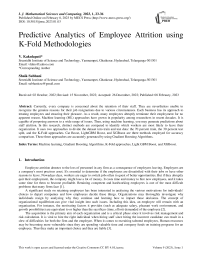Predictive Analytics of Employee Attrition using K-Fold Methodologies
Автор: V. Kakulapati, Shaik Subhani
Журнал: International Journal of Mathematical Sciences and Computing @ijmsc
Статья в выпуске: 1 vol.9, 2023 года.
Бесплатный доступ
Currently, every company is concerned about the retention of their staff. They are nevertheless unable to recognize the genuine reasons for their job resignations due to various circumstances. Each business has its approach to treating employees and ensuring their pleasure. As a result, many employees abruptly terminate their employment for no apparent reason. Machine learning (ML) approaches have grown in popularity among researchers in recent decades. It is capable of proposing answers to a wide range of issues. Then, using machine learning, you may generate predictions about staff attrition. In this research, distinct methods are compared to identify which workers are most likely to leave their organization. It uses two approaches to divide the dataset into train and test data: the 70 percent train, the 30 percent test split, and the K-Fold approaches. Cat Boost, LightGBM Boost, and XGBoost are three methods employed for accuracy comparison. These three approaches are accurately generated by using Gradient Boosting Algorithms.
Machine learning, Gradient Boosting Algorithms, K-Fold approaches, Light GBM Boost, and XGBoost
Короткий адрес: https://sciup.org/15019043
IDR: 15019043 | DOI: 10.5815/ijmsc.2023.01.03
Список литературы Predictive Analytics of Employee Attrition using K-Fold Methodologies
- https://www.digitalhrtech.com/employee-attrition.
- https://www.shrm.org/hr-today/trends-and-forecasting/special-reports-and-expert-views/documents/retaining-talent.pdf.
- Pestano, T. (2018). Manila Recruitment. Retrieved from https://manilarecruitment.com/manilarecruitment-articles-advice/risks-in-recruitment-process-and-how-to-mitigate-them/.
- Alduayj, S. S. & Rajpoot, K. 2018. Predicting Employee Attrition using Machine Learning. International Conference on Innovations in Information Technology. DOI: 10.1109/INNOVATIONS.2018.8605976.
- https://www.clearpeaks.com/predicting-employee-attrition-with-machine-learning-using-knime/
- V. Kakulapati, et al. (2020) Predictive analytics of HR - A machine learning approach, Journal of Statistics and Management Systems, 23:6, 959-969, DOI: 10.1080/09720510.2020.1799497.
- Usha, P.; et al. Analysing Employee attrition using machine learning. Karpagam J. Comput. Sci. 2019, 13, 277–282.
- Cotton, J.L. and Tuttle, J.M., 1986. “Employee turnover: A meta-analysis and review with implications for research” Academy of management review, pp.55-70.
- Liu, D., Mitchell, T.R., Lee, T.W., Holtom, B.C. and Hinkin, T.R., 2012. “When employees are out of step with coworkers: How job satisfaction trajectory and dispersion influence individual and unit-level voluntary turnover.” Academy of Management Journal, pp.1360-1380.
- Heckert, T.M. and Farabee, A.M., 2006. “Turnover intentions of the faculty at a teaching-focused university.” Psychological reports, pp.39-45.
- https://expertsystem.com/machine-learning-definition/
- Tom Mitchell, 1997, Machine Learning, McGraw Hill.
- Chen, T., et al. Xgboost: A scalable tree boosting system. In: Proceedings of the 22nd ACM sigkdd international conference on knowledge discovery and data mining, pp. 785–794, ACM (2016).
- Raschka, S.: Python Machine Learning. Packt Publishing Ltd, Birmingham (2015).
- M. Stoval et al. "Voluntary turnover: Knowledge management – Friend or foe?", Journal of Intellectual Capital, 3(3), 303-322, 2002.
- Rohit Punnoose et al. "Prediction of Employee Turnover in Organizations using Machine Learning Algorithms- A case for Extreme Gradient Boosting," International Journal of Advanced Research in Artificial Intelligence, Vol. 5, No. 9, 2016, pp:22-26.
- T. Chen and C. Guestrin, "XGBoost: Reliable Large-scale Tree Boosting System, 2015", Retrieved from http://learningsys.org/papers/LearningSys_2015_paper_32.pdf. Accessed 12 December 2015.
- Ozden G¨ur Ali and Umut Arit¨urk. Dynamic churn prediction framework with more ¨ effective use of rare event data: The case of private banking. Expert Syst. Appl., 41:7889– 7903, 2014.
- Fawcett, T., 2006. An introduction to ROC analysis. Pattern recognition letters, pp.861-874.


